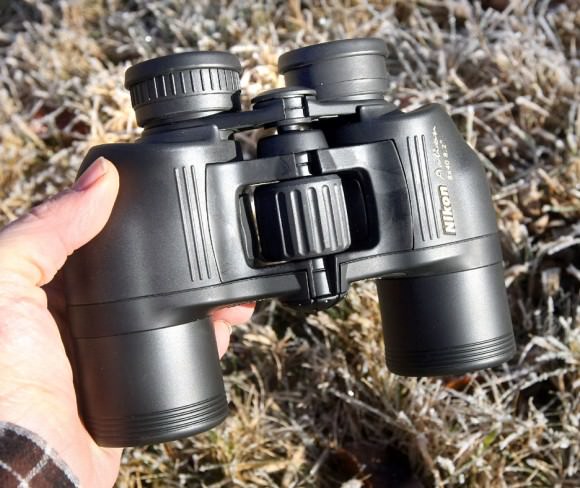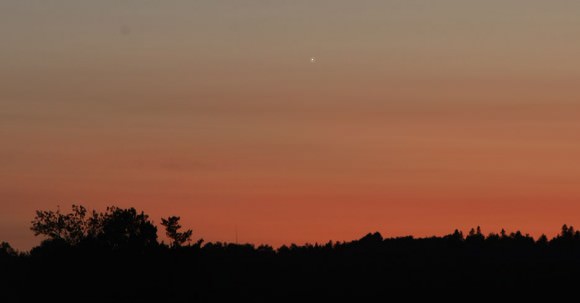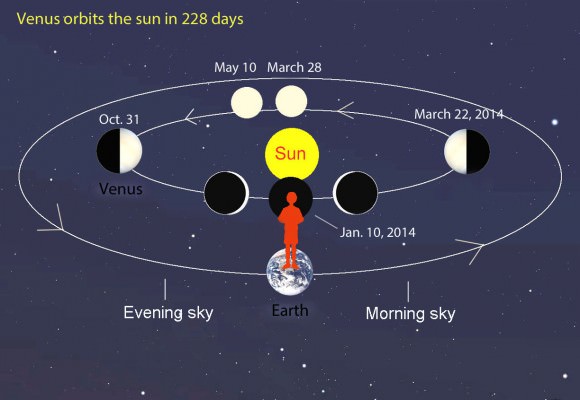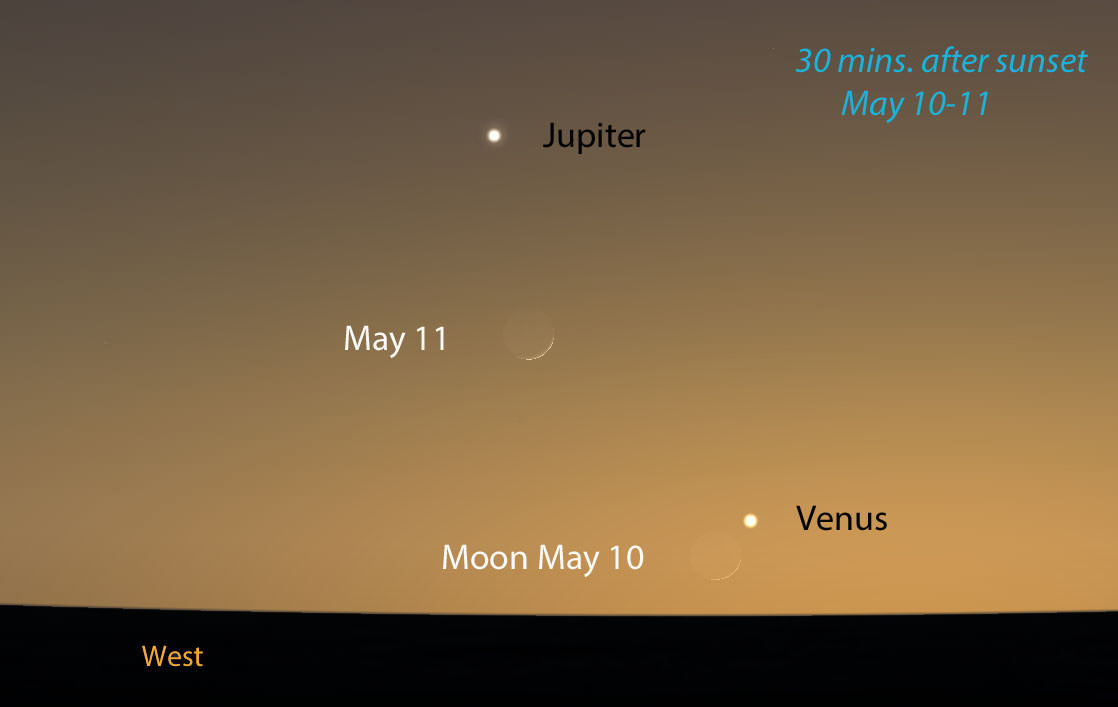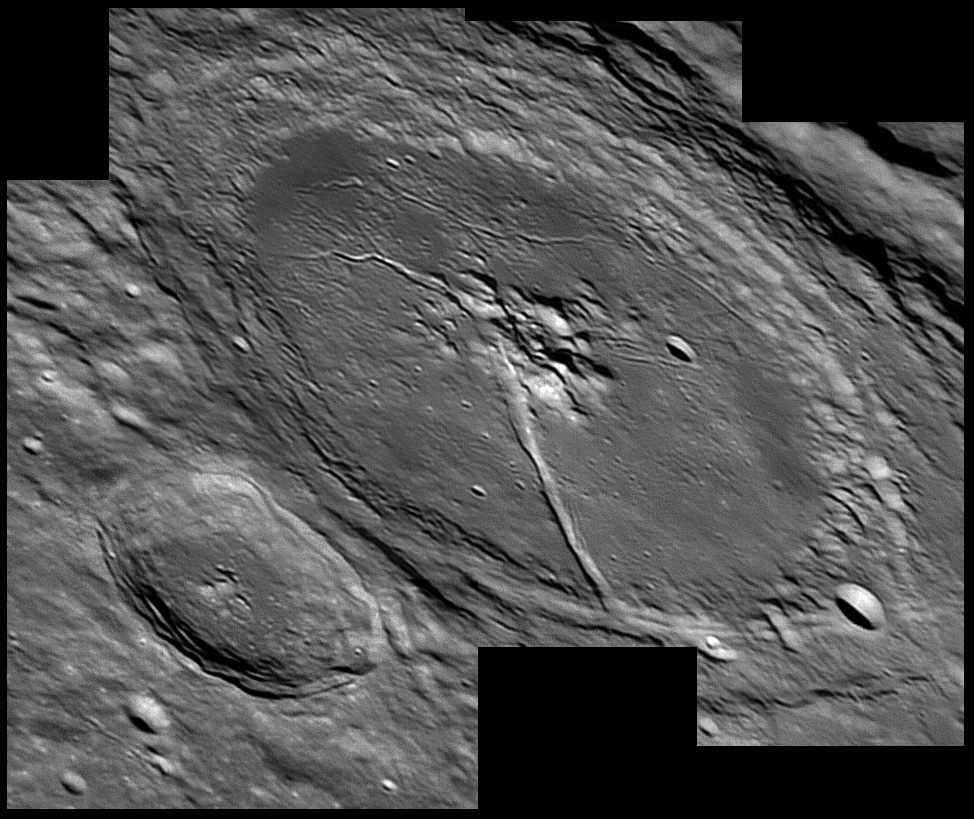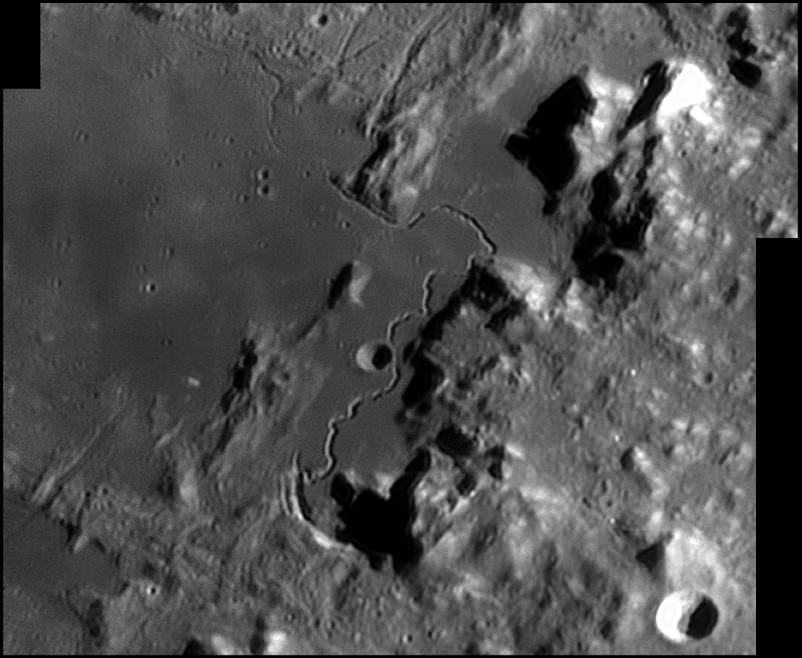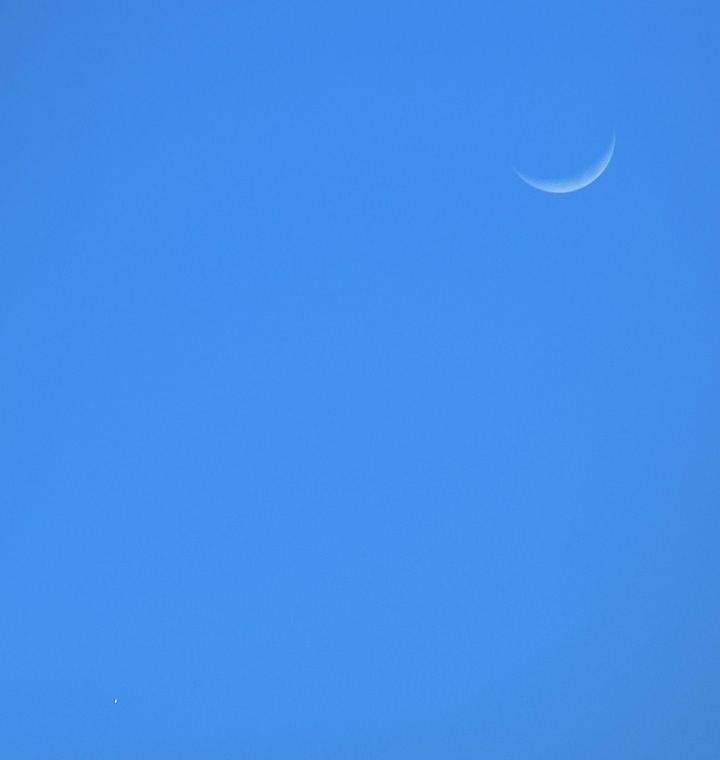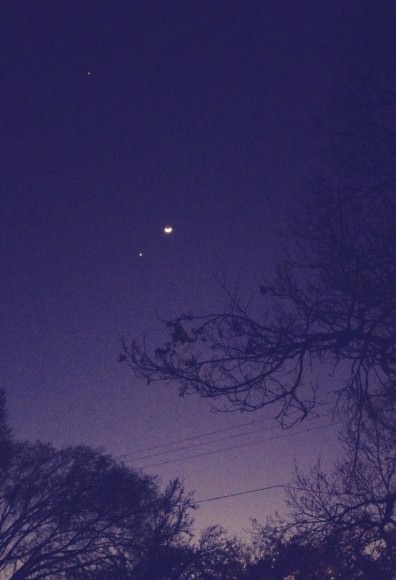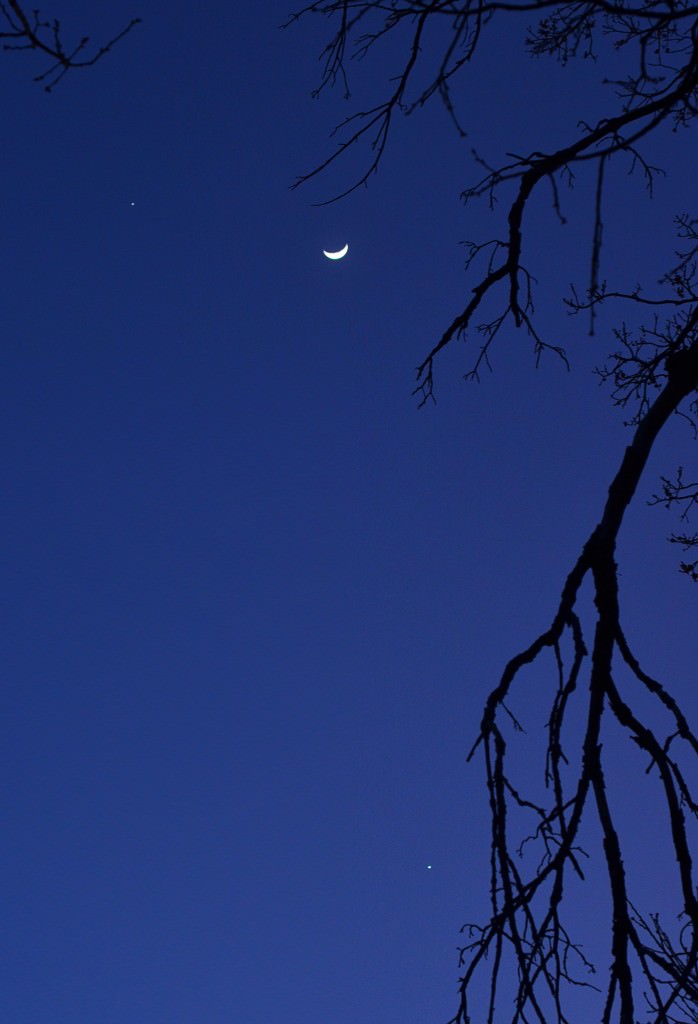[/caption]
Greetings, fellow SkyWatchers! As the Venus Transit draws closer, our bright neighboring planet is quickly disappearing into the sunset glow. As we await this astronomical piece of history, let’s take the time this week to have a look at a host of wonderful lunar features and bright stars. Be sure to catch the conjunction of Spica, Saturn and the Moon – and to catch a shooting star from the Tau Herculid meteor shower! If you’re ready to learn more about the history, mystery and magic of astronomy, then grab your optics and meet me in the back yard…
Monday, May 28 – On this day in 1959, the first primates made it to space. Abel (a rhesus monkey) and Baker (a squirrel monkey) lifted off in the nose cone of an Army Jupiter missile and were carried to sub-orbital flight. Recovered unharmed, Abel died just three days later from anesthesia during an electrode removal, but Baker lived on to a ripe old age of 27.
Our first challenge for the evening will be a telescopic one on the lunar surface known as the Hadley Rille. Using our past knowledge of Mare Serenitatis, look for the break along its western shoreline that divides the Caucasus and Apennine mountain ranges. Just south of this break is the bright peak of Mons Hadley. You’ll find this area of highest interest for several reasons, so power up as much as possible.
Impressive Mons Hadley measures about 24 by 48 kilometers at its base and reaches up an incredible 4572 meters. If this mountain was indeed caused by volcanic activity on the lunar surface, this would make it comparable to some of the very highest volcanically caused peaks on Earth, such as Mount Shasta or Mount Rainer. To its south is the secondary peak Mons Hadley Delta – the home of the Apollo 15 landing site just a breath north of where it extends into the cove created by Palus Putredinus.
Along this ridgeline and smooth floor, look for a major fault line known as the Hadley Rille, winding its way across 120 kilometers of lunar surface. In places, the rille spans 1500 meters in width and drops to a depth of 300 meters below the surface. Believed to have been formed by volcanic activity some 3.3 billion years ago, we can see the impact that lower gravity has had on this type of formation, since earthly lava channels are less than 10 kilometers long and only around 100 meters wide.
During the Apollo 15 mission, Hadley Rille was visited at a point where it was only 1.6 kilometers wide – still a considerable distance as seen in respect to astronaut James Irwin and the lunar rover. Over a period of time, its lava may have continued to flow through this area, yet it remains forever buried beneath years of regolith.
Now let’s head about four fingerwidths northwest of Beta Virginis for another unusual star – Omega. Classed as an M-type red giant, this 480 light-year distant beauty is also an irregular variable which fluxes by about half a magnitude. Although you won’t notice much change in this 5th magnitude star, it has a very pretty red coloration and is worth the time to view.
Tuesday, May 29 – Today in 1919, a total eclipse of the Sun occurred and stellar measurements taken along the limb agreed with predictions based on Einstein’s General Relativity theory – the first such confirmation. Although we call it gravity, space/time curvature deflects the light of stars near the limb, causing their apparent positions to differ slightly. Unlike today’s astronomy, at that time you could only observe stars near the Sun’s limb (within less than an arc second) during an eclipse. It’s interesting to note that even Newton had his own theories on light and gravitation which predicted some deflection!
Tonight on the Moon we’ll be looking for another challenging feature and a crater which conjoins it – Stofler and Faraday.
Located along the terminator to the south, crater Stofler was named for Dutch mathematician and astronomer Johan Stofler. Consuming lunar landscape with an immense diameter of 126 kilometers and dropping 2760 meters below the surface, Stofler is a wonderland of small details in an eroded surrounding. Breaking its wall on the north is Fernelius, but sharing the southeast boundary is Faraday. Named for English physicist and chemist Michael Faraday, it is more complex and deeper at 4090 meters, but far smaller at 70 kilometers in diameter. Look for myriad smaller strikes which bind the two together!
If you’re up for a bit more of a challenge, then let’s head about 59 light-years away in Virgo for star 70. You’ll find it located about 6 degrees northeast of Eta and right in the corner of the Coma, Bootes, and Virgo border. So what’s so special about this G-type, very normal-looking 5th magnitude star?
It’s a star that has a planet.
Long believed to be a spectroscopic binary because of its 117 day shifts in color, closer inspection has revealed that 70 Virginis actually has a companion planet. Roughly 7 times larger than Jupiter and orbiting no further away than Mercury from its cooler-than-Sol parent star, 70 Virginis B just might well be a planet cool enough to support water in its liquid form.
How “cool” is that? Try about 85 degrees Celsius…
Wednesday, May 30 – Are you ready to explore some more history? Then tonight have a look at the Moon and identify Alphonsus – it’s the centermost in a line of rings which looks much like the Theophilus, Cyrillus and Catharina trio.
Alphonsus is a very old, Class V crater which spans 118 kilometers in diameter and drops below the surface by about 2730 meters and contains a small central peak. Partially flooded, Eugene Shoemaker had made of study of this crater’s formation and found dark haloes on the floor. Again, this could be attributed to volcanism and Shoemaker believed them to be maar volcanoes, and the haloes to be dark ash. Power up and look closely at the central peak, for not only did Ranger 9 hard land just northeast, but this is the only area on the Moon where an astronomer has observed a change and back up that observation with photographic proof.
On November 2, 1958 Nikolai Kozyrev’s long and arduous study of Alphonsus was about to be rewarded. Some two years earlier Dinsmore Alter had taken a series of photographs from the Mt. Wilson 60? reflector that showed hazy patches in this area that could not be accounted for. Night after night, Kozyrev continued to study at the Crimean Observatory – but with no success. During the process of guiding the scope for a spectrogram the unbelievable happened – a cloud of gas containing carbon molecules had been captured! Selected as the last target for the Ranger photographic mission series, Alphonsus delivered 5814 spectacular high-resolution images of this mysterious region before Ranger 9 splattered nearby.
Capture it yourself tonight!
Now let’s add to our double star list as we hunt down Zeta Bootes located about 7 degrees southeast of Arcturus. This is a delightful multiple star system for even small telescopes.
Thursday, May 31 – As we begin the evening, be sure to note a splendid conjunction. Tonight the waxing Moon will dominate the sky, but it’s joined by the visage of Spica and Saturn. Look for the brilliant star located just to the lunar north and the gentle giant planet about 10 degrees or so further north.
Now, let’s have a look at awesome crater Clavius. As a huge mountain-walled plain, Clavius will appear near the terminator tonight in the lunar southern hemisphere, rivaled only in sheer size by similar structured Deslandres and Baily. Rising 1646 meters above the surface, the interior wall slopes gently downward for a distance of almost 24 km and a span of 225 km. Its crater-strewn walls are over 56 km thick!
Clavius is punctuated by many pockmarks and craters; the largest on the southeast wall is named Rutherford. Its twin, Porter, lies to the northeast. Long noted as a test of optics, Clavius crater can offer up to thirteen such small craters on a steady night at high power. How many can you see?
While the glare will make it difficult to do many things, we can still have a look at other bright objects! Let’s start tonight by going just north of Zeta Bootes for Pi. With a wider separation, this pair of whites will easily resolve to the smaller telescope.
Now skip up northeast about a degree for Omicron Bootes. While this is not a multiple system, it makes for a nice visual pairing for a binocular challenge. For telescopes, the southeastern star holds interest as a small asterism.
Continue northeast another two degrees to discover Xi Bootes. This one is a genuine multiple star system with magnitude 5 and 7 companions. Not only will you enjoy this G-type sun for its duplicity, but for the fine field of stars in which it resides!
Now have a look at Mars. Over the last few weeks it has dropped significantly in brightness and has now reached an approximate +0.5 magnitude. Have you been watching its progress against the background stars? It won’t be long until it crosses constellation boundaries again.
Friday, June 1 – Tonight on the Moon, crater Copernicus will try to steal the scene, head further south to capture another lunar club challenge – Bullialdus. Even binoculars can make out this crater with ease near the center of Mare Nubium. If you’re scoping – power up – this one is fun! Very similar to Copernicus, note Bullialdus’ thick, terraced walls and central peak. If you examine the area around it carefully, you can note it is a much newer crater than shallow Lubiniezsky to its north and almost non-existent Kies to the south. On Bullialdus’ southern flank, it’s easy to make out its A and B craters, as well as the interesting little Koenig to the southwest.
Now let’s have a look at a tasty red star – R Hydrae. You’ll find it about a fistwidth south of Spica or about a fingerwidth west of Gamma Hydrae.
R was the third long term variable star to be discovered and it is credited to Maraldi in 1704. While it had been observed by Hevelius some 42 years earlier, it was not recognized immediately because its changes happen over more than a year. At maximum, R reaches near 4th magnitude – but drops well below human eye perception to magnitude 10. During Maraldi’s and Hevelius’ time, this incredible star took over 500 days to change, but it has speeded up to around 390 days in the present century.
Why such a wide range? Science isn’t really sure. R Hydrae is a pulsing M-type giant whose evolution may be progressing more rapidly than expected due to changes in structure. What we do know is that it is around 325 light-years away and is approaching us at around 10 kilometers per second.
In the telescope, R will have a pronounced red coloration which deepens near minima. Nearby is 12th magnitude visual companion star Ho 381, which was first measured for position angle and distance in 1891. Since that time no changes in separation have been noted, which leads us to believe that the pair may be a true binary.
Saturday, June 2 – Tonight would be a wonderful opportunity for Moongazers to return to the surface and have a look at the peaceful Sinus Iridum area. If you’ve been clouded out before, be sure to have a look for telescopic lunar club challenges – Promontoriums Heraclides and LaPlace.
Now let’s return again to R Hydrae. While observing a variable star with either the unaided eye, binoculars, or a telescope can be very rewarding, it’s often quite difficult to catch changes in long-term variables, because there are times when the constellation is not visible. While R Hydrae is unique in color, let’s drop about half a degree to the southeast to visit another variable star – SS Hydrae.
SS is a quick change artist – the Algol-type. While you will need binoculars or a telescope to see this normally 7.7 magnitude star, at least its fluctuations are far more rapid, with a period of only 8.2 days. With R Hydrae we have a star that expands and contracts causing the changes in brightness – but SS is an eclipsing binary. While less than a half magnitude is not a noteworthy amount, you will notice a difference if you view it over a period of time. Be sure to note that this is actually a triple star system, for there is also a 13th magnitude companion star located 13? from the primary. Watch if as often as possible and see if you can detect changes in the next few weeks!
Sunday, June 3 – If you’re up early, why not keep a watch out for the peak of the Tau Herculids meteor shower? These are the offspring of comet Schwassman-Wachmann 3, which broke up in 2006. The radiant is near Corona Borealis and we’ll be in this stream for about a month. At best when the parent comet has passed perihelion, you’ll catch about 15 per hour maximum. Most are quite faint and the westering Moon will interfere, but sharp-eyed observers will enjoy it.
Tonight let’s have a look at a very bright and changeable lunar feature that is often over-looked. Starting with the great grey oval of Grimaldi, let your eyes slide along the terminator towards the south until you encounter the bright crater Byrgius. Named for Joost Burgi, who made a sextant for Tycho Brahe, this “seen on the curve” crater is really quite large with a diameter of 87 kilometers. Perhaps one of the most interesting features of all is high albedo Byrgius A, which sits along its east wall line and produces a wonderfully bright ray system. While it is not noted as a lunar club challenge, it’s a great crater to help add to your knowledge of selenography!
Now let’s try a visual double for the unaided eye – Eta Virginis. Can you distinguish between a 4th and 6th magnitude pair?
The brighter of the two is Zaniah (Eta), which through occultation had been discovered to be a triple star. In 2002, Zaniah became the first star imaged by combining multiple telescopes with the Navy Prototype Optical Interferometer. This was the first time the three were split. Two of them are so close that they orbit in less than half the distance between the Earth and Sun!
Binocular users should take a look at visual double Rho Virginis about a fistwidth west-southwest of Epsilon. This pair is far closer and will require an optical aid to separate. The brighter of this pair – Rho – is a white, main sequence dwarf with a secret… It’s a variable! Known as a Delta Scuti type, this odd star can vary slightly in magnitude in anywhere from 30 minutes to two and a half hours as it pulsates.
For mid-to-large telescopes, Rho offers just a little bit more. The visual companion star has a visual companion as well! Less than a half degree southwest of Rho is a small, faint spiral galaxy – NGC 4608 (Right Ascension: 12 : 41.2 – Declination: +10 : 09) – at 12th magnitude, it’s hard to see because of Rho’s brightness…but it’s not alone. Look for a small, but curiously shaped galaxy labeled NGC 4596 (Right Ascension: 12 : 39.9 – Declination: +10 : 11). Its resemblance to the planet Saturn makes it well worthwhile!
Until next week? Ask for the Moon, but keep on reaching for the stars!
